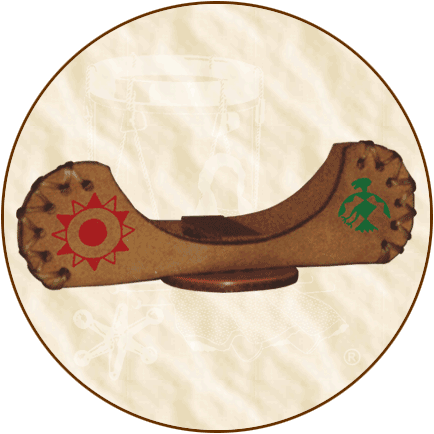.
Continued from product description on
Native American's Page One...
Historical
Background: Canoes may well be Man's earliest boat when
he made dugout canoes from tree trunks. This type of canoe was
originally made by burning one side of a log to hollow it out.
It was probably during the Bronze Age that Man began carving
or hacking out the tree's core for a boat. As Man became more
sophisticated with his tools and skills to use them, so did his
canoes.
In parts of North America, Native Americans made small boats
constructed of birch bark and cedar trees. The bark was held
together with tree roots and tree gum. This type of canoe later
became an important means of transportation for early European
explorers and fur traders in the New World.
The size of canoes ranged from 40-foot vessels for transporting
cargo to the smaller passenger canoes. Canoes for 2-4 people
were sleek in design and highly efficient for maneuvering in
rivers and on lakes. Huge oceangoing dugouts were used along
the Pacific Ocean's northern coast of North America. Canoes used
by French fur traders in Canada could carry up to 12 people,
along with a cargo weighing around 2,400 kilograms. Some Native
Americans built canoes to an incredible size and could carry
up to 50 paddlers!
The intended use of a canoe dictated its design. This was
truly a water craft where form followed function. Besides dugout
and bark canoes, there were also closed-deck kayaks used in northern
waters where the water is frigid. The design of a canoe was dictated
by the local materials and conditions where it was built. Each
canoe was also unique. Every canoe builder contributed his individual
skills and cultural traditions to the overall design. Canoes
and kayaks were designed for transportation, hunting, fishing,
trade, warfare, gifts, and ceremonies.
Using canoes (and kayaks) requires strength and speed from
the paddler(s). These are the same skills needed for canoe racing.
By the way, racing contests were another use of canoes by Native
Americans.
Birch bark canoes were generally used in the northeastern
United States as well as the central and southeastern regions
of Canada. The bark of birch trees was used to "skin"
the wooden ribs of the canoe's hull. This bark was usually stitched
together with spruce roots, and spruce gum was used to seal the
cracks so it would not let water get inside the canoe. As with
other types of canoes, the birch bark canoe's overall design
and construction were influenced by its intended use. Canoes
were specifically built to travel across smooth, rough, and fast-running
waters such as lakes, coastal shores, and rivers, respectively
speaking.
Birch bark was an ideal material for canoes. It is not only
lightweight, waterproof, and resilient; the inside of the bark
is smooth and allows the canoe to easily glide or "cut through"
water. When one thinks of a birch bark canoe, one might tend
to image a canoe with white birch bark sides. However, the white
side of the bark was always on the inside of the canoe because
of its rough surface.
One characteristic associated with canoes is the shape of
the bow and stern. This "tapered-ends look," however,
also varied according to the region where the canoe was built.
No matter which variety of form a canoe had, it was an optimal
solution for a given need. This is why canoes have remained relatively
unchanged for thousands of years!
Fun
Fact: The French fur trade business created such a demand
for canoes, that the first known canoe factory was established
around 1750 in Trois-Rivieres, Quebec, Canada.
Fun
Fact: Bark canoes were stored in one of two ways. They
were either kept from excessive light and moisture by being elevated
upside-down, covered and placed in a shaded area; or, they were
weighted down with rocks and completely submerged in a lake or
pond!













